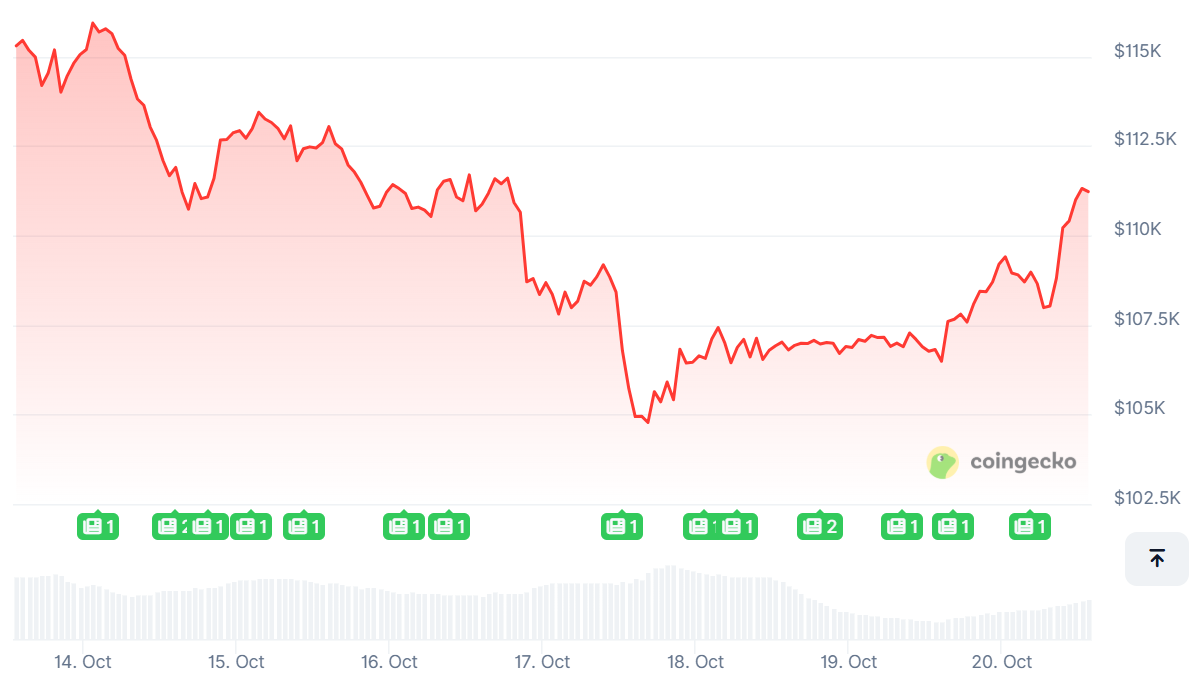Despite hopes for a seasonal "October" rebound, sentiment around Bitcoin and altcoins remains under pressure due to geopolitical risks, aggressive liquidations, and shaky safe-haven status—although potential rate cuts by the Federal Reserve could still change the situation.
Author: ASHRITH RAO
Translated by: Baihua Blockchain

In recent weeks, geopolitical news has been a driving factor in the cryptocurrency market, with investors viewing digital assets as risk bets.
Bitcoin extended its weekend recovery into Monday, rising 4.2% to over $111,000, after plummeting 4% to around $103,350 last weekend, marking its lowest level since June.
During last week's sell-off, the cryptocurrency market evaporated over $600 billion.

The reversal over the weekend and the surge in cryptocurrencies on Monday occurred after U.S. President Donald Trump attempted to ease trade tensions with Beijing and confirmed that he would hold his first face-to-face meeting with Chinese Premier Xi Jinping during his term at next week's Asia-Pacific Economic Cooperation (APEC) summit.
On October 10, the cryptocurrency market experienced a flash crash, with a record $20 billion liquidated in just a few hours, leading to over 1.6 million traders being forced out. Bitcoin sharply dropped from a historic high of over $125,000 to below $110,000.
This sell-off followed Trump's threat to impose a 100% tariff on new export regulations for Chinese rare earth minerals. However, after the market crash, the U.S. president softened his rhetoric, calming investor sentiment by stating that high tariffs were unsustainable.
This clearly reflects that geopolitical news is driving the cryptocurrency market, while cryptocurrencies failed to maintain their safe-haven asset label.
On the other hand, gold has been hitting new highs, soaring to nearly $4,400 per ounce last week amid broader market turmoil, including cryptocurrencies.
The Worst October in the Last 10 Years?
"October" is often referred to as "Uptober" by cryptocurrency traders, reflecting the historical tendency for Bitcoin to see significant rebounds during this month.
However, this year's performance is heading towards the most disappointing since 2015, having dropped 5% so far. Historically, October has an average gain of about 20%, while November stands out with an impressive 42%, making it the strongest month for asset performance.
Broader economic and geopolitical risks have overshadowed seasonal trends. The ongoing tariff conflict between the U.S. and China, combined with low liquidity and a series of leveraged liquidations, has collectively limited potential gains.
Last week, Bitcoin's drop below $107,000 led to an additional $1.2 billion being liquidated, clearing out long positions established after the September rebound. During that week, Ethereum, Solana, and BNB fell by 4-7%, while smaller tokens like DOGE and ADA experienced significant declines of over 20%.
The "red" trend in October this year is not without precedent, but it remains a rare occurrence. In the past 12 years, Bitcoin has only experienced monthly closing prices below the previous month in two years—2014 and 2018 (the latter with a decline of 3%).
In 2020, Bitcoin experienced a significant reversal, turning a loss at the beginning of October into a 27% surge by the end of the month, paving the way for the following year's historic highs.
Opportunities for a Turnaround, Betting on Fed Rate Cuts
With two weeks left in the month, there remains a chance for a turnaround in the market.
Despite macroeconomic challenges, market participants are still betting on the Federal Reserve cutting rates this month and ending the current phase of quantitative tightening early, which could once again boost cryptocurrencies. The FedWatch tool from the Chicago Mercantile Exchange (CME Group) currently shows a 98.9% probability of a 25 basis point rate cut at next week's meeting.
A Two-Phase Story
The cryptocurrency narrative for 2025 marks two distinct phases.
The first phase saw cryptocurrencies rise as a safe-haven asset alongside gold, a trend that has recently been broken.
Bitcoin's first breakthrough above $100,000 was achieved with the combined push of safe-haven demand and soaring gold prices. Financial institutions capitalized on the cryptocurrency market's rise to new highs, frantically applying for numerous exchange-traded funds (ETFs) related to altcoins. Altcoins are assets on the fringes of digital finance, known for their unpredictability and low trading volumes.
However, in the recent phase, cryptocurrency trading has resembled that of extreme risk assets. As altcoins experienced sharp declines, a significant amount of market capitalization evaporated, highlighting the low liquidity and volatility that persist in many assets within this space.
In the past week, some tokens experienced declines of about 70%, as liquidity weakened and buying interest disappeared. This harshly reminds us that despite product developers' efforts to adapt to compliant markets, a large part of the digital asset landscape still reflects a chaotic financial frontier. The current market crash is a prime example of these concerns.
According to data collected by Bloomberg Intelligence, there are currently about 130 ETF applications related to small crypto tokens awaiting review by the U.S. Securities and Exchange Commission (SEC). This includes funds related to Polkadot, Chainlink, and Pengu (a meme coin associated with Pudgy Penguins).
Originally launched in 2013 as a humorous concept, Dogecoin now has a functional ETF trading under the code DOJE, attracting $38 million in inflows. However, after the market downturn, no one is laughing now. The current slump, while not as tumultuous as the 2022 digital asset crisis, is still raising new concerns.
On Friday, worries about credit market pressures reignited price declines, with an altcoin index plummeting by as much as 11%, hitting its lowest point since April. This clearly indicates how quickly the entire landscape of speculative assets can be wiped out.
The current administration (referring to the Trump administration) has encouraged issuers to seek more risky products. Some documents even include monitoring "Trump" and "Melania" cryptocurrencies with double-leveraged instruments.
Nevertheless, traders are still betting that the broader cryptocurrency market will be boosted, anticipating that Federal Reserve policy easing will bring about the next sustainable rally.
Article link: https://www.hellobtc.com/kp/du/10/6085.html
Source: https://www.blockhead.co/2025/10/20/will-cryptos-finally-get-the-much-touted-uptober-rally/
免责声明:本文章仅代表作者个人观点,不代表本平台的立场和观点。本文章仅供信息分享,不构成对任何人的任何投资建议。用户与作者之间的任何争议,与本平台无关。如网页中刊载的文章或图片涉及侵权,请提供相关的权利证明和身份证明发送邮件到support@aicoin.com,本平台相关工作人员将会进行核查。




